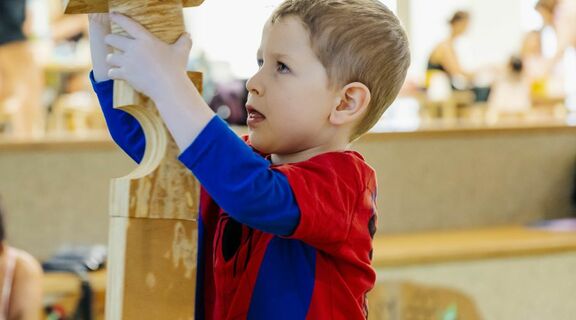
What is open-ended play?
28 November 2024 | State Library of Queensland
There are so many ways to play and one of the best has no rules, no boundaries and no instructions.
It’s the type of play where a child can make their own decisions, limited only by their imagination; where they create their own world and make their own decisions.
We call this open-ended play.
You don’t need expensive toys or a list of instructions. Your child just needs time and space to be creative.
Take for instance, a basket of wooden spoons, blocks and soft balls. For your child, this is an invitation to imagine and experiment ... the balls are planets, the blocks become buildings and the spoons are spaceships! Your child has created and directed their own space adventure with all the words, actions, sounds and emotions to go with their story!
The opposite of this type of play is called closed-ended. Playing with puzzles, shape sorters, matching or memory games requires more structure and has a pre-determined outcome or end goal. Closed-ended play builds distinctly different skills that are equally important for development and lifelong learning, such as:
- Attention span
- Reasoning
- Self-regulation
- Following instructions
- Fine motor
- Turn taking
Closed-ended play often requires facilitation and guidance from an adult, but the rewards of mastery and sense of achievement for your child are priceless.
A balance of closed and open-ended play is essential to building a strong foundation for future learning and development.
A little more on open-ended play
Children are naturally creative and inventive and will often see opportunities we don’t, which is why open-ended play can keep a child busy for hours! And with a little help from you (your child’s favourite toy) you can support safe play by observing, listening and modelling language through role play or problem solving together in an open-ended way.
This might look like asking questions such as “Does this block go here or here?” or “How can I make this stack higher without it falling?” or “I wonder what would happen if we ...”
Playing alongside your child helps them understand new things and strengthens your bond with them.
The hidden benefits of open-ended play are found in the process of play, not the product. The process of creating, building and exploring through problem solving builds understanding of and connection to the real world. And when there are no rules, children are less afraid to fail.
It’s the process of play that shapes your child’s brain and their potential for learning later in life.
Here are some ways you can invite open-ended play at home:
- Turn boxes into a tunnel, cubby or train
- Set up sand and water play
- Wooden blocks and animal figurines invite small world play
- Play dough or clay with pattern makers
- Take a nature walk to collect items like dry leaves, flowers, twigs and stones that can be used in play once you get home
- Stack stones in a sunny spot outside – the lizards will thank you!
- Put together a dress-up box with fabrics in different colours and textures – faux fur, felt scraps, old clothes, feathers, sheets and blankets – explore the way they feel
- Make sensory baskets with bottle caps, buttons and baubles for older children or put interesting items like feathers or bells in tightly sealed plastic containers for little ones to safely explore.
If you are still not sure whether it’s closed or open-ended play, ask yourself, does this toy or activity allow my child to make choices or does it tell them how to play? And remember, there is no right or wrong way to play.
Blogs on this topic:
Comments
Your email address will not be published.
We welcome relevant, respectful comments.